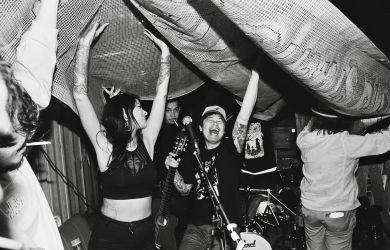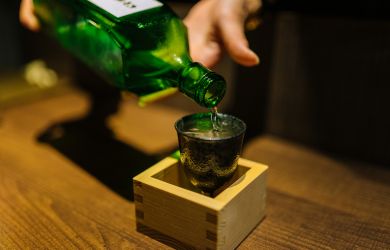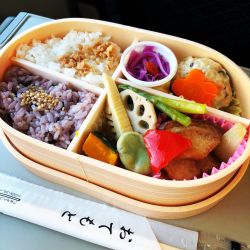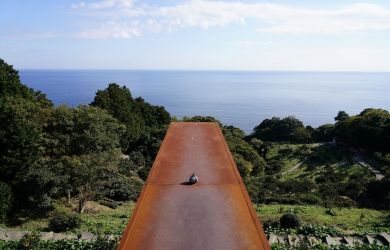
September 17, 2009
Teko Cave
Novice climbers get to grips with the sport at this Brazilian-run gym
By Metropolis
Originally published on metropolis.co.jp on September 2009

Photos Courtesy of Teko Cave
This article could easily turn into a story entirely about Carlos Barbosa. The Brazilian rock-climbing enthusiast has had an interesting life, to say the least. After first coming to Tokyo in 1996 to study aikido, he worked his way up off the streets only to find himself homeless again in 2000, when he was forced to abandon his job as a diving instructor in Miyakejima after the volcano on the island erupted. Passing over years spent studying oceanography in California and piloting underwater ROVs for a Japanese company recovering military debris brings this brief biography up to the present, and to the actual topic at hand: Teko Cave.
Barbosa, 35, and his Brazilian partner Robison Ribeiro opened this freestyle bouldering gym in Yokohama in May. The word Teko means “natural” in the Guarani language of Paraguay and southern Brazil, while the “cave” part is obvious from the sloping walls and undulating ceiling. The facilities are designed to be accessible and inviting to climbers of any level, but particularly to newcomers.
“The climbing scenario hasn’t changed in Japan for a while,” explains Barbosa, who is fluent in Portuguese, Spanish, English and Japanese. “It’s the same people climbing the same places. It’s a very small, tight group, and it is hard for new people to get in.” Women, too, can be put off by the testosterone-heavy, grunting environment of a hardcore gym. Barbosa’s wife Yuri, 28, also a climber and licensed yoga instructor, confirms this. “The smell is usually really bad,” she says.

By comparison, Teko Cave looks like a playground, with colorful grips and footholds protruding from the lumpy, vaguely Surrealist, reddish-brown interior. The floor is one big soft cushion, and there is nary a hint of offensive odors. Beginners can start with the challenge of getting straight from bottom to top, while advanced climbers have the option of zigzagging across the half-dome or scaling the ceiling.
There are no set lessons at Teko; however, the marked routes demand practicing specific techniques, and there are staff on hand to spot and demonstrate tricky moves. Barbosa stresses the importance of individual training. “With rock climbing, you are only competing against yourself and nature. It is something that I get a kick out of and wanted to share with other people.”
On the Saturday that I joined the Barbosa family at Teko Cave, the gym was filled with more women than men, though this gradually changed as the day wore on. I arrived first for Ms Barbosa’s weekly yoga class, an hour-long session designed for climbers to improve strength and flexibility. In practice, this means the kind of yoga that has you balancing on one arm, body trembling.
Following that, I had my first introduction to climbing, despite an initial spindly-armed protest. This turned out to involve more than a simple test of strength, as the additional challenge of maintaining balance with each move, I learned, enhances self-awareness. After nailing the “G” course on my third try, I joined some regulars for a chatty, impromptu lunch of delivery tacos. This, I learned, was a typical day for the “Teko family,” for whom the social aspect is part of the gym’s appeal.

For Barbosa, however, Teko Cave is also a means to an end. “I want to get people outdoors,” he says. On Wednesdays and Sundays he organizes half-day excursions in the Kanto area that serve as real lessons on how to use gear properly, climb safely, and keep one’s environmental impact to a minimum. Just to prove that he’s serious about making climbing as accessible as possible, the fee is a mere ¥4,000 per person.
In addition to these regular activities, Teko also hosts surfing trips and weekend outings to swim with dolphins off the coast of the now-habitable Miyakejima. “Living in Brazil, everybody used the outdoors,” Barbosa reflects. “Brazil may be a third world country, but this is something that it can show a first world country like Japan.”
For newcomers keen to give climbing a try, every Sunday from noon is “first-time climber’s hour,” during which entry and rental shoes are free. Teko Dolphin trips will run through October (minimum of four people required), and Teko Cave will host a climbing wall in Osaki during the long weekend of September 19-22, as part of the Banff Mountain Film Festival.
402 Wayside Bldg, 1-8 Daimachi, Kanagawa-ku, Yokohama. Tel: 045-512-2661. Open Mon-Fri 1pm-11pm, Sat, Sun & hols 12pm-8pm. Nearest stn: Yokohama, west exit. http://tekoonline.com








